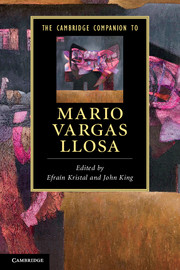Book contents
- Frontmatter
- Introduction
- 1 Reality and rebellion: An overview of Mario Vargas Llosa’s literary themes
- 2 The early novels: The Time of the Hero and The Green House
- 3 The total novel and the novella: Conversation in The Cathedral and The Cubs
- 4 Humour and irony: Captain Pantoja and the Special Service and Aunt Julia and the Scriptwriter
- 5 The historical novel: The War of the End of the World
- 6 Innocence and corruption: Who Killed Palomino Molero? and The Storyteller
- 7 The political novels: The Real Life of Alejandro Mayta and Death in the Andes
- 8 The erotic novels: In Praise of the Stepmother and The Notebooks of Don Rigoberto
- 9 The dictator novel: The Feast of the Goat
- 10 From utopia to reconciliation: The Way to Paradise, The Bad Girl and The Dream of the Celt
- 11 The essays
- 12 The memoir: A Fish in the Water
- 13 The plays
- 14 Film and the novels
- 15 An interview
- Further reading
- General index
- Index of selected fictional characters
- Index of selected works by Vargas Llosa
1 - Reality and rebellion: An overview of Mario Vargas Llosa’s literary themes
Published online by Cambridge University Press: 28 January 2012
- Frontmatter
- Introduction
- 1 Reality and rebellion: An overview of Mario Vargas Llosa’s literary themes
- 2 The early novels: The Time of the Hero and The Green House
- 3 The total novel and the novella: Conversation in The Cathedral and The Cubs
- 4 Humour and irony: Captain Pantoja and the Special Service and Aunt Julia and the Scriptwriter
- 5 The historical novel: The War of the End of the World
- 6 Innocence and corruption: Who Killed Palomino Molero? and The Storyteller
- 7 The political novels: The Real Life of Alejandro Mayta and Death in the Andes
- 8 The erotic novels: In Praise of the Stepmother and The Notebooks of Don Rigoberto
- 9 The dictator novel: The Feast of the Goat
- 10 From utopia to reconciliation: The Way to Paradise, The Bad Girl and The Dream of the Celt
- 11 The essays
- 12 The memoir: A Fish in the Water
- 13 The plays
- 14 Film and the novels
- 15 An interview
- Further reading
- General index
- Index of selected fictional characters
- Index of selected works by Vargas Llosa
Summary
A life in movement
The house where Vargas Llosa was born, on 28 March 1936, has wooden railings, a small front garden and a door flanked by white columns. Relatively close to Arequipa's Plaza de Armas, at Boulevard Parra 101, its façade looks today much as it did eight decades ago. Mario lived there with his grandparents, Don Pedro Llosa and Doña Carmen Ureta; and his mother, Dora, went to church from that home on her wedding day.
Vargas Llosa, however, was too young to have a conscious recollection of his first home. He was only a year old when the Llosa clan, led by his maternal grandfather, moved to Cochabamba in Bolivia, where he would live for the next nine years. In 1946 he returned to Peru to study at the La Salle school in Piura, a city in the northern coastal area of Peru where he would set the brothel that gave the title to his second novel, published in 1966, The Green House (La casa verde). In 1947 he would go to Lima, and become a cadet in the military academy he would immortalise in his first novel in 1963, The Time of the Hero (La ciudad y los perros). He returned to Piura in 1952, and moved back to Lima the following year to begin his university studies, a period that inspired the literary world of Conversation in The Cathedral (Conversación en La Catedral).
Arequipa, Cochabamba, Piura, Lima: by the time he was sixteen years old, he had moved six times and had lived in two countries and four different cities. When Vargas Llosa was eleven years old, he learned of the existence of his father, whom his family had led him to believe was dead since he was a little boy. Until then he had idealised his father from a photo in which he appeared, friendly and smiling, in a sailor’s cap. The authoritarian, irascible man who came into his life was a stark contrast to Mario’s fantasies of a caring father he had lost as a little boy.
- Type
- Chapter
- Information
- The Cambridge Companion to Mario Vargas Llosa , pp. 9 - 21Publisher: Cambridge University PressPrint publication year: 2011



